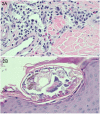Crusted Scabies Induced Hypereosinophilic Syndrome
- PMID: 34178521
- PMCID: PMC8221644
- DOI: 10.7759/cureus.15201
Crusted Scabies Induced Hypereosinophilic Syndrome
Abstract
Crusted scabies causes extensive hyperkeratotic skin lesions, crusting, and scaling and is common in elderly and institutionalized patients. We present a case of crusted scabies in a patient with encephalopathy and diffuse exfoliative erythroderma. After extensive workup, the patient's condition was attributed to hypereosinophilic syndrome due to crusted scabies. Skin condition, mental status, and eosinophilia improved with high-dose steroids in conjunction with topical permethrin and oral ivermectin.
Keywords: crusted scabies; erythroderma; hypereosinophilia; hypereosinophilic syndrome; hyperkeratotic skin lesions.
Copyright © 2021, Shrestha et al.
Conflict of interest statement
The authors have declared that no competing interests exist.
Figures



Similar articles
-
Diagnostic dilemma: crusted scabies superimposed on psoriatic erythroderma in a patient with acquired immunodeficiency syndrome.Skinmed. 2007 May-Jun;6(3):142-4. doi: 10.1111/j.1540-9740.2007.05723.x. Skinmed. 2007. PMID: 17483659
-
Treatment of crusted scabies with albendazole: A case report.Dermatol Online J. 2009 Oct 15;15(10):17. Dermatol Online J. 2009. PMID: 19951635
-
Crusted Hyperkeratotic Scabies: A Case Report.Cureus. 2023 Feb 1;15(2):e34520. doi: 10.7759/cureus.34520. eCollection 2023 Feb. Cureus. 2023. PMID: 36879685 Free PMC article.
-
Crusted (Norwegian) scabies in patients with AIDS: the range of clinical presentations.South Med J. 1994 Mar;87(3):352-6. doi: 10.1097/00007611-199403000-00011. South Med J. 1994. PMID: 8134858 Review.
-
Crusted scabies in a renal transplant recipient treated with daily ivermectin: A case report and literature review.Transpl Infect Dis. 2019 Jun;21(3):e13077. doi: 10.1111/tid.13077. Epub 2019 Mar 29. Transpl Infect Dis. 2019. PMID: 30873722 Review.
References
-
- Hypereosinophilic syndrome. Curtis C, Ogbogu P. Clin Rev Allergy Immunol. 2016;50:240–251. - PubMed
-
- Crusted scabies: clinical and immunological findings in seventy-eight patients and a review of the literature. Roberts LJ, Huffam SE, Walton SF, Currie BJ. J Infect. 2005;50:375–381. - PubMed
-
- Centers for Disease Control and Prevention. Epidemiology and Risk Factors of Scabies. [Apr;2021 ];https://www.cdc.gov/parasites/scabies/epi.html
Publication types
LinkOut - more resources
Full Text Sources
